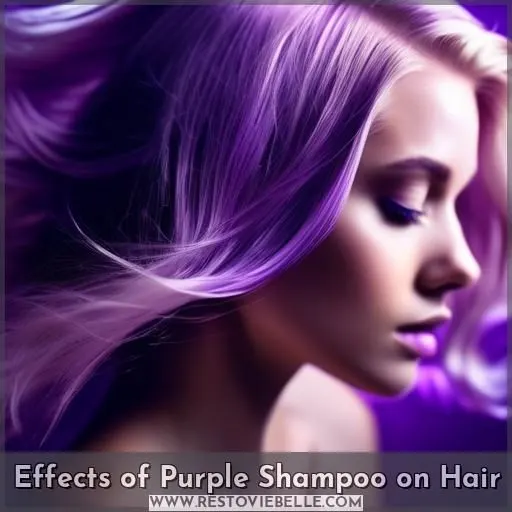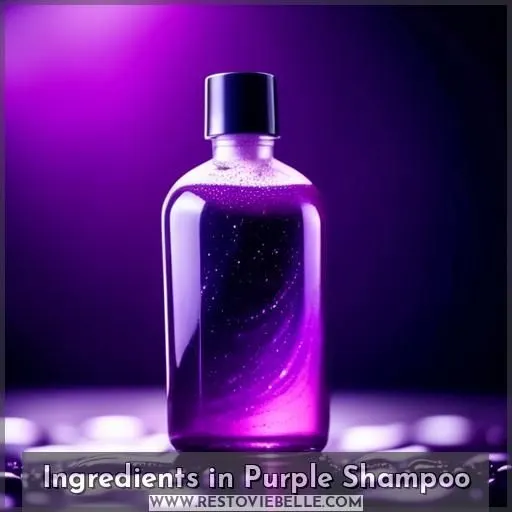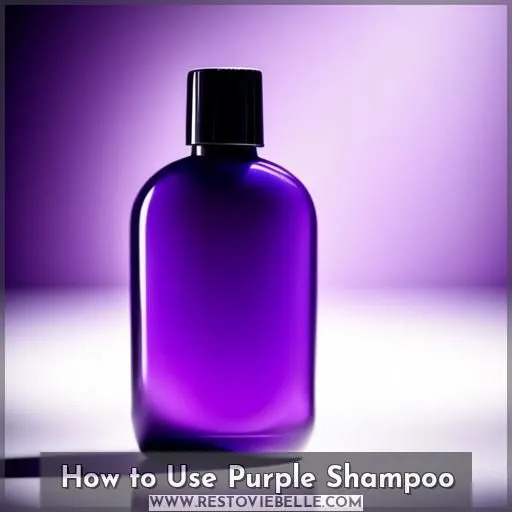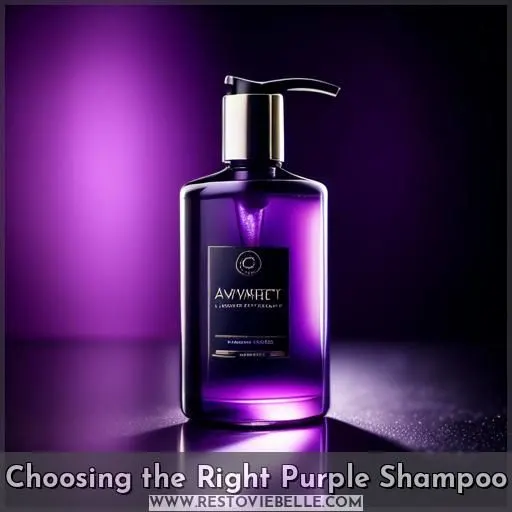This site is supported by our readers. We may earn a commission, at no cost to you, if you purchase through links.
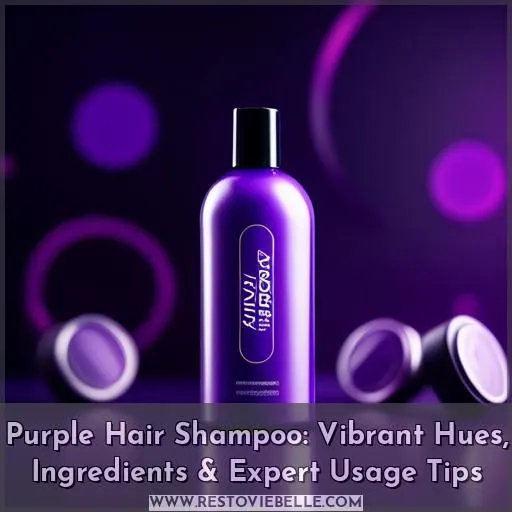
You’re ready to immerse yourself in the alluring world of purple hair shampoo!
This dynamic formula transforms locks into cooler, enchanting shades while nourishing strands with revitalizing ingredients like argan oil, biotin, keratin, and bamboo fiber.
When using your purple shampoo, cleanse first with regular shampoo. Lather the purple formula into damp hair. Let it work its wonders for 2-5 minutes, then rinse thoroughly.
You’ll uncover expert advice on selecting the ideal paraben and phthalate-free purple shampoo crafted specifically for your hair’s unique requirements.
Table Of Contents
Key Takeaways
- Purple hair shampoo is designed to neutralize brassy tones and enhance cool shades in blonde, highlighted, gray, and silver hair, with a recommended usage of once or twice a week to avoid over-toning and maintain hair health.
- Key ingredients like argan oil, biotin, keratin, and bamboo fiber in purple shampoo formulas provide nourishment and protection for the hair, while also promoting strength and growth.
- When selecting a purple shampoo, it’s important to choose products that are free from parabens, phthalates, gluten, and other potential allergens or irritants to ensure safety for all hair types, including color-treated and sensitive scalps.
- Purple shampoos can be both affordable and eco-friendly, with options available that are vegan, cruelty-free, hypoallergenic, and made with sustainable packaging, catering to a variety of personal preferences and environmental considerations.
Effects of Purple Shampoo on Hair
Embrace the power of purple shampoo to transform your hair into a vibrant, cooler color. This shampoo is designed to target brassy or orange tones, ensuring your hair is toned to your desired shade.
With a commitment to product safety, purple shampoo is hypoallergenic, cruelty-free, and free from harmful ingredients like parabens, phthalates, and gluten.
The subtle blue cast during application indicates potential toning, while the medicinal smell dissipates after hair dries.
Some users may notice a slight darkening of their hair color, particularly in white hairs, but overall, hair condition remains neutral.
Experience the benefits of this affordable, vegan, and eco-friendly shampoo, priced around $20 for a shampoo or $26 for a shampoo and conditioner set.
Ingredients in Purple Shampoo
Purple shampoo and conditioner series, such as the one by Botanic Hearth, contain a variety of beneficial ingredients for hair care. These products are formulated to protect hair color and keep it from looking brassy or yellow. Some of the key ingredients include:
- Argan oil: Known for its softening and repairing properties, argan oil is rich in vitamin E and squalene, which protect the hair from external aggressions like pollution, sun, and cigarette smoke.
- Biotin: A B-vitamin that promotes hair growth and strength.
- Keratin: A protein that helps to strengthen and repair damaged hair.
- Bamboo fiber: Known for its ability to add volume and texture to hair.
- Taro extract: A natural ingredient that helps to condition and nourish hair.
These ingredients work together to provide a deep cleansing and brightening effect, while also nourishing and protecting the hair. The purple pigments in the shampoo and conditioner help to neutralize brassy tones and enhance cool tones in blonde, highlighted, gray, and silver hair.
In addition to these ingredients, these products are also free from harmful substances like SLS, parabens, phthalates, gluten, and other allergens. They’re also cruelty-free, hypoallergenic, and color-safe, ensuring that they’re suitable for all hair types and don’t cause irritation or damage to color-treated hair.
How to Use Purple Shampoo
To use purple shampoo effectively, follow these steps:
- Wash your hair with your regular shampoo to remove dirt and unwanted buildup.
- Apply the purple shampoo to wet hair, focusing on the roots and lengths.
- Massage the shampoo into a lather, allowing the purple color to turn into a lavender, soapy-foam consistency.
- Let the shampoo sit for 2-5 minutes, depending on the level of brassiness and desired ashy tone.
- Rinse thoroughly with lukewarm water, followed by a purple conditioner to add moisture back to your strands.
Remember to use purple shampoo once or twice a week, as overuse can lead to a buildup of purple pigments, resulting in a dull or ashy color. It’s also essential to avoid using purple shampoo every day, as it can strip your hair of natural oils, leaving it dry and brittle.
Choosing the Right Purple Shampoo
When choosing the right purple shampoo, you’ll want to pay close attention to the ingredients list. Opt for formulas that are free from parabens, phthalates, gluten, and other potential allergens or irritants, as these can be drying or harmful to your hair and scalp.
parabens
When hunting for the perfect purple shampoo, dodge the paraben pitfall.
These preservatives can be a double-edged sword, potentially leading to scalp irritation and long-term health concerns.
Instead, opt for paraben-free potions that promise vibrant locks without the worry.
After all, who wants to play Russian roulette with hair damage when there are safer shampoo alternatives riding in to save the day?
phthalates
Phthalates are a class of chemicals widely used in plastic products to improve flexibility.
They are also found in cosmetics and personal care products to bind fragrance.
They’ve been linked to health effects such as reproductive toxicity and endocrine disruption.
In California, they have been banned in children’s toys and child care products since 2009.
The US Consumer Product Safety Commission (CPSC) voted to ban five types of phthalate chemicals from children’s toys and products in 2017.
Additionally, the National Center for Health Research reports that the Consumer Product Safety Improvement Act permanently bans certain kinds of phthalates (BBP, DBP, and DEHP) from toys and child care products.
It temporarily bans other phthalates (DIDP, DINP, and DnOP).
gluten
When it comes to choosing the right violet shampoo, gluten is an important consideration for those with gluten allergies or sensitivities. Here are four key points to keep in mind:
- Gluten-Free Shampoo: Look for violet shampoos that are clearly labeled as gluten-free. This guarantees that the product doesn’t contain any gluten or wheat-derived ingredients, which can be troublesome for those with gluten intolerance or celiac disease.
- Cross-Contamination: Be aware of potential cross-contamination in the manufacturing process. Some shampoos may be produced in facilities where gluten-containing products are also made, which could result in trace amounts of gluten in the final product.
- Ingredient List: Always check the ingredient list to make sure that the shampoo doesn’t contain any gluten-containing ingredients. Common gluten-containing ingredients include hydrolyzed wheat protein, hydrolyzed wheat starch, and wheat germ oil.
- Patch Test: Before using a new shampoo, perform a patch test on your inner arm to check for any potential allergic reactions. This is especially important for those with gluten allergies, as reactions can range from mild irritation to severe allergic reactions.
and other allergens. Additionally
When selecting the ideal purple shampoo, it’s crucial to take into account the ingredients and their potential influence on hair well-being, veganism, environmental responsibility, affordability, and your own preferences. Here are some essential aspects to keep in mind:
- SLS (Sodium Lauryl Sulfate): This element is a typical foaming agent in shampoos, but it can be harsh on hair and cause irritation. Seek out sulfate-free options if you have sensitive skin or wish to avoid harsh chemicals.
- Parabens: These are preservatives frequently used in shampoos to prevent bacterial growth. Some individuals choose to avoid parabens due to possible health concerns. Opt for paraben-free options if this is a concern for you.
- Phthalates: These are plasticizers that can be present in certain shampoos. They’ve been linked to health issues, so it’s advisable to avoid products containing phthalates.
- Gluten: If you have celiac disease or are gluten intolerant, make certain that the shampoo is gluten-free.
- Other Allergens: Be aware of any other allergens or irritants that may be found in the shampoo. Check the label for any ingredients to which you may be sensitive.
- Veganism: If you adhere to a vegan lifestyle, seek out shampoos that are certified vegan and devoid of ingredients derived from animals.
- Sustainability: Take into account the environmental impact of the shampoo. Look for products with sustainable packaging, made from recycled materials, and produced using renewable energy.
- Budget-Friendly: If you’re on a budget, there are numerous affordable options available at drugstores. Search for shampoos that provide good value for money without compromising on quality.
Conclusion
Showcase the vibrant allure of purple hair shampoo, transforming your locks into a captivating, cool-toned masterpiece. With nourishing ingredients and expert usage, you’ll reveal a radiant, revitalized mane that commands attention. Embrace the power to customize your perfect paraben and phthalate-free formula, designed specifically for your unique hair needs – the path to luminous, multi-dimensional purple tresses awaits.
